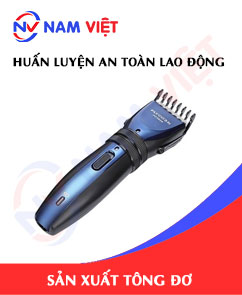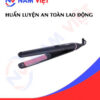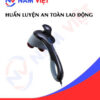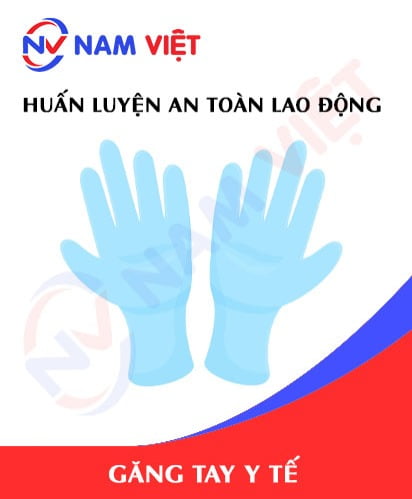Occupational Safety Training in Hair Clipper Manufacturing
99,000 ₫
Note: The above price is calculated for one person, the price may fluctuate depending on the number of trainees participating in the course and depending on market movements. For more accurate pricing support, please refer to the quotation table or contact our consulting staff directly.
Occupational safety is an important issue in hair clipper manufacturing factories and needs to be addressed promptly to ensure the health and safety of workers, and to enhance the reputation of businesses. The Occupational safety training course is one of the effective solutions to raise awareness about accident prevention for workers participating in hair clipper manufacturing.
Table of Contents
Toggle1. Overview of Hair Clippers
a. What is a hair clipper?
A hair clipper is a tool used for trimming hair. Hair clippers are commonly used by barbers and hair salons, and can also be used at home for self-haircutting. Hair clippers can be used to cut hair on the head, eyebrows, and facial hair of men.

b. Types of machinery used in hair clipper production
The hair clipper manufacturing process may involve various types of machinery, depending on each stage of production. Some commonly used machines include:
- Lathes: for processing parts of the hair clipper such as blades, housing, etc.
- Milling machines: for shaping and processing hair clipper components.
- Grinding machines: for sharpening clipper blades.
- Plastic injection machines: for molding plastic components of the housing.
- 3D printers: for producing complex parts of the hair clipper, enhancing precision and optimizing the production process.
- Hardness testers: for checking the hardness of blades and other components.
- Metal pressing machines: for assembling metal parts of the hair clipper together.

c. Hair clipper manufacturers in Vietnam
In Vietnam, there are several well-known brands in hair clipper production, including:
- Hatson: A well-known brand of Hatson Electronics Manufacturing and Trading Company Limited, specializing in producing and distributing hair clippers and related products.
- Kiki: A brand of Kiki Trading and Services Company Limited, offering high-quality and diverse hair clipper products.
- Moser: A brand of Wahl Group, specializing in hair-cutting products and hair clippers, widely distributed in Vietnam.
- Gemei: A well-known brand of Gemei Medical and Dental Equipment Manufacturing and Trading Company Limited, producing high-quality hair clippers at affordable prices.
- Philips: A renowned brand of Philips Vietnam Electronics and Computer Company Limited, producing and distributing hair and scalp care products, including hair clippers.
d. Specific jobs in a hair clipper manufacturing factory
Group 1
- Executive director, deputy director, department heads in the hair clipper manufacturing factory.
Group 2
- Safety officers: manage factory safety, design safety procedures, supervise and ensure employees follow safe working practices.
Group 3
- Material procurement: Main materials include stainless steel, plastic, and copper.
- Component fabrication: Components manufactured include blades, power supply units, motors, and other hair clipper parts.
- Assembly: Components are assembled into the final product, including installation, inspection, and packaging.
- Quality control: All products undergo strict quality inspection to ensure proper functioning and compliance with safety standards.
- Packaging and distribution: Products are fully packaged and shipped to retailers or distributors.
Group 4
- Office, service, sales, and marketing jobs.
- Production management, quality management, human resources, material management, finance, and accounting management.
- Product design and research: The factory requires a team of design and technical staff to develop new hair clippers and optimize product functionality and features.

2. Overview of Occupational Safety Training for Hair Clipper Production
This article focuses on issues related to Group 3 because Group 3 directly participates in production and faces the highest occupational safety risks. For information on other groups, see here.
a. What is Group 3 occupational safety training?
- Group 3 occupational safety training consists of sessions that raise awareness among workers on how to prevent workplace accidents.
- The training helps workers identify and avoid hazards, reducing the risk of workplace accidents during their work.
REGISTER FOR OCCUPATIONAL SAFETY TRAINING SERVICE
b. Training duration
Initial safety training duration
- Total training time is at least 24 hours, including testing time.
- 8 hours of theory on policies, laws on occupational safety and hygiene
- 8 hours of theory on basic occupational safety and hygiene knowledge
- 4 hours of theory on specialized training content
- 2 hours of practical training on specialized content
- 2 hours of theoretical testing at the end of the course
The safety training center will schedule sessions depending on employees’ availability, typically consisting of 6 sessions over 3 days, assuming continuous learning time is arranged by the manufacturer.
Periodic safety training duration
- Before the occupational safety card expires, workers who want to renew it must attend a periodic occupational safety training course, with the duration being at least 50% of the initial safety training time.
Explanation: The total periodic occupational safety training time is at least 12 hours, including testing time. After completing the course and passing the test, workers will be reissued and have their occupational safety card renewed.
c. Training content
| No. | TRAINING CONTENT | TRAINING DURATION (HOURS) | |||
| Total | Including | ||||
| Theory | Practice | Testing | |||
| I | System of policies and occupational safety laws | 8 | 8 | 0 | 0 |
| 1 | Overview of the legal and regulatory system on occupational safety and hygiene. | 6 | 6 | ||
| 2 | Standards and technical regulations for occupational safety and hygiene. | 1 | 1 | ||
| 3 | Specific regulations of state management agencies regarding safety and hygiene during construction, expansion, or renovation of facilities, as well as for the production, use, storage, and inspection of machines, equipment, materials, and substances requiring strict safety and hygiene measures. | 1 | 1 | ||
| II | Basic knowledge of occupational safety and hygiene | 8 | 8 | 0 | 0 |
| 1 | Basic knowledge of hazardous and harmful factors in the workplace. | 4 | 4 | ||
| 2 | Methods to improve working conditions. | 1 | 1 | ||
| 3 | Safety culture in production and business. | 1 | 1 | ||
| 4 | Rights and obligations of employers and employees; policies and regulations on occupational safety and hygiene; roles and responsibilities of safety staff. | 1 | 1 | ||
| 5 | Safety regulations, signs, instructions, use of safety equipment, personal protective equipment, first aid skills, and occupational disease prevention. | 1 | 1 | ||
| III | Specialized training content | 6 | 4 | 2 | 0 |
| Comprehensive knowledge of machinery, equipment, substances generating hazardous and harmful factors; risk analysis, assessment, and management; safe working procedures with machines, equipment, and substances requiring strict safety measures. | 6 | 4 | 2 | ||
| IV | Final training assessment | 2 | 2 | 0 | 0 |
| Total | 24 | 22 | 2 | ||
See more training content of 6 groups
d. Occupational safety card
After completing occupational safety training and passing the test, workers will be issued an occupational safety card (commonly called occupational safety certificate for Group 3).
The Group 3 safety card shows information such as name, date of birth, job, and specific working environment. It also includes training duration, a red seal, and signature confirming course completion.
According to the regulations for issuing safety cards stated in Clause 2 of Article 24 of Decree 44/2016/ND-CP, there are two cases:
- If the employer and employee have a labor contract, the employer must sign, stamp, and certify the safety card for Group 3 trainees after they complete the training course from an occupational safety training unit and pass the test.
- If the worker is freelance or temporary and does not have a labor contract, the training unit must sign, stamp, and certify the safety card after the worker completes the training course and passes the test.

3. Identifying hazards affecting workers in hair clipper production
Some potential hazards in hair clipper manufacturing include:
- Mechanical hazards: Machines in the hair clipper factory can pose risks if not properly maintained and operated. There is also a risk of cuts, entrapment, or crushing if safety procedures are not followed.
- Chemical hazards: Using chemicals for cleaning or processing hair clippers can be hazardous. Without proper protective equipment, workers may be exposed to harmful fumes.
- Electrical hazards: If electrical devices are not regularly maintained, properly insulated, or waterproofed, there is a risk of electric shock during production.
- Height hazards: Heavy equipment or materials may be placed at elevated positions, creating a risk of falling from heights.
- Noise hazards: Machines in the factory generate high noise levels. Without ear protection, workers may suffer hearing damage.
- Physical impact hazards: Workers may be injured by cuts, punctures, or collisions when handling tools, equipment, and materials during production.
4. Common Occupational Accidents for Workers in Hair Clipper Production
During the production of hair clippers, the common occupational accidents include:
- Cutting or injury: Employees may be cut or injured by the blades or cutting edges of clippers during production and assembly.
- Electric shock: Workers may suffer electric shock when exposed to high voltage during assembly or testing of clippers.
- Chemical poisoning: During production, chemicals such as solvents and cleaning agents can cause poisoning if not used properly.
- Injury from high temperatures: During production, using compressors and other equipment to cool clippers may pose danger if not used properly.
- Finger or hand laceration: Workers may cut fingers or hands while operating machinery and equipment during production and assembly.
- Other accident injuries: Other accidents include being crushed by machinery or heavy objects, slipping, falling, or impact injuries.

5. Safety Measures When Participating in Hair Clipper Production
Safety measures when participating in hair clipper production may include:
- Providing protective equipment: The factory must provide full protective equipment for workers, including helmets, safety glasses, gloves, safety shoes, masks, and shields at the workplace.
- Ensuring machinery safety: Machines must be regularly maintained and inspected before use to ensure worker safety.
- Occupational safety training: Employees need to be trained on safety procedures and proper use of protective equipment.
- Conducting regular inspections: The factory must carry out regular inspections to detect early faults, technical errors, and implement timely corrective measures.
- Using safe materials: The factory must use safe, quality-checked materials to ensure products meet safety and hygiene standards.
- Ensuring hygiene safety: The factory must ensure workplace hygiene during production, including cleaning work areas, machinery, surfaces, and other related tools and equipment.
- Creating a safe working environment: The factory must provide a safe working environment with adequate lighting, ventilation, humidity, and temperature to ensure workers’ health and well-being.
- Risk management: The factory must implement risk management measures to prevent workers from direct exposure to hazardous and dangerous chemicals during production.
- Periodically conduct occupational environment monitoring in factories, collect and analyze harmful factors for workers, and adjust to reduce risks to prevent occupational diseases.
6. Benefits of Occupational Safety Training in Hair Clipper Production
An Toan Nam Viet provides enterprises with the following excellent benefits after completing occupational safety training courses in accordance with Decree 44/2016/ND – CP on labor safety and hygiene for companies, factories, and businesses:
- Workers can identify potential occupational hazards and take preventive measures to avoid accidents.
- Enterprises can establish risk prevention measures in production, operation, and maintenance processes.
- Reduce costs when occupational safety risks occur.
- Continuous production helps increase labor productivity and product quality.
- Comply with labor safety laws, avoiding legal risks.
- Create credibility and professionalism in all aspects, thereby enhancing the enterprise’s brand value.
Nam Viet training courses are solutions to prevent external risks affecting individuals so they can avoid dangers that could lead to injuries or, in severe cases, death.
REGISTER FOR OCCUPATIONAL SAFETY TRAINING SERVICE
7. Customer Feedback After Completing Occupational Safety Training in Hair Clipper Production
An Toan Nam Viet has many years of experience accompanying enterprises in Vietnam in general and southern provinces in particular. This responsibility is extremely valuable to Nam Viet, which is why its Occupational Safety Training is increasingly professional. The motivation for An Toan Nam Viet’s growth comes from both positive feedback and suggestions from enterprises. Below are the feedbacks from our partners we have served.
Bac Nam E&C Construction Investment Joint Stock Company
“My first experience using An Toan Nam Viet’s service surprised me with 24/7 enthusiastic support from the consulting team. Organizing the class was quick and convenient for our company. Thank you very much for Nam Viet’s service!”
Hoa Dat Construction and Trading Joint Stock Company
“Nam Viet’s service has helped us greatly in simplifying occupational safety and completing safety documentation for work processes. The consulting team is enthusiastic and timely in answering our questions. 5 stars for Nam Viet.”
See more customer interviews after using the service of An Toan Nam Viet
8. An Toan Nam Viet’s Occupational Safety Training Capacity
An Toan Nam Viet is a reputable and high-quality occupational safety training center in Vietnam. Training sessions are continuously conducted at factories, production workshops, or construction sites across the country (63 provinces in Vietnam).
REGISTER FOR OCCUPATIONAL SAFETY TRAINING SERVICE
Occupational Safety Training License
- An Toan Nam Viet has been inspected and certified by the Department of Safety under the Ministry of Labor, War Invalids and Social Affairs, granting certification for occupational safety and hygiene training. This strengthens our training capacity.

Materials and Lectures
- Before being used in occupational safety training courses, training materials are reviewed to ensure accuracy and effectiveness.
- Teaching methods follow An Toan Nam Viet standards, developed by experts in occupational safety and hygiene training to maximize knowledge absorption.
Facilities
- Controlling classroom factors affecting training increases teaching efficiency and learning outcomes.
- Our training facilities provide spacious classrooms meeting standards for area, lighting, and training equipment.
9. Nationwide Reputable Occupational Safety Training Center
At An Toan Nam Viet, we prioritize professional occupational safety training. Educating workers on self-protection equips them for safe work, contributing to national development.
To ensure effective training, we meticulously prepare everything, from tools and teaching equipment to curricula, materials, audio, and lighting.
Our trainers are experts with many years of experience, including research on identifying hazards across industries and how to prevent them.
Lectures are practical, vividly presented, and easily understood by workers, helping them learn comfortably while adhering to Decree 44/2016/ND-CP.
Workers learn hazard prevention measures and how to protect themselves, applying them effectively in real work situations.
Our training center is proud to provide professional and reputable occupational safety training with advantages such as:
- Competitive training costs while maintaining quality.
- Flexible training schedules aligned with production needs.
- Quick certification procedures in compliance with the law.
- Experienced trainers with long-term expertise.
- Classrooms controlled to maximize teaching efficiency and learning outcomes.
- Lectures tailored for occupational safety in enterprises.
- An Toan Nam Viet provides dedicated, professional support for customers promptly and accurately.

10. Additional Reference Materials for Occupational Safety Training in Hair Clipper Production
- Occupational Safety Materials for Hair Clipper Production
- Occupational Safety Training Materials
- Occupational Safety Training Test Collection
- Occupational Safety Training Curriculum for Hair Clipper Production
- Occupational Safety Quiz for Hair Clipper Production
1 review for Occupational Safety Training in Hair Clipper Manufacturing
No comments yet















namchinh.haiphong341
Dịch vụ huấn luyện an toàn lao động rất tốt nhé, giảng viên dạy rất sinh động dễ hiểu!